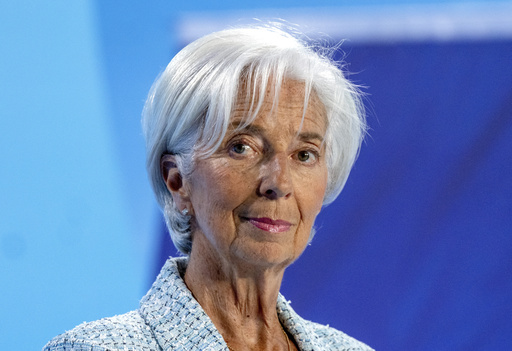FRANKFURT, Germany (AP) — Inflation in the 20-nation eurozone crept lower to 2.5% in June, but remained stuck above the level favored by the European Central Bank, which is in no hurry to add more rate cuts after a first tentative reduction in its benchmark rate.
The figure released Tuesday was down from 2.6% in May, welcome news as inflation continues to fall from its peak of 10.6% that robbed consumers of spending power and mired the European economy in months of near-zero growth.
But key indicators Tuesday remained at levels that suggest inflation may remain stuck between 2% and 3% for a while yet. Inflation in services prices ran at 4.1%, unchanged from the month before.
The ECB’s caution in making sure inflation is under control comes as the U.S. Federal Reserve holds off on cutting rates from current highs. The central banks don’t want to belatedly discover that inflation is more stubborn than they thought and reverse course — a mistake that would make inflation harder to wring out of the economy and would ding their credibility into the bargain.
High rates aim to squelch inflation by making it more expensive to borrow money to buy goods or invest in new factory equipment. That relieves pressure on prices — but can also dampen growth. That’s the tightrope the ECB and the Fed are trying to walk: make sure inflation is contained, without pushing their economies into recession.
ECB President Christine Lagarde said in a speech on Monday that the bank needed to first make sure inflation was firmly under control before cutting its key rate again after a first, quarter-point cut at its June 6 meeting to the current 3.75%.
“It will take time for us to gather sufficient data to be certain that the risks of above target inflation have passed,” Lagarde said in a speech at an ECB conference in Sintra, Portugal. She said that though growth in the eurozone was uncertain, the jobs market remained strong with low unemployment levels. That is a sign that the economy is holding up even with rates much higher than before.
Even so, higher rates have held back credit-sensitive areas such as real estate and construction. Mortgage rates for house purchase have risen, and a yearslong rally in house prices in the eurozone has come to an end. Savers, however, are seeing relief from the earlier period of zero rates that saw some banks paying negative interest on savings — in other words, charging people to keep their money there.
Lagarde has characterized the first rate cut in June as merely “moderating the level of restriction” on the economy and not as the start of a rapid series of cuts. She says decisions will be based on incoming data on a meeting-to-meeting basis.
Analysts say that no cut is likely at the bank’s meeting July 18, meaning the discussion about rates remains focused on the bank’s September meeting.
The European economy has slogged through quarter after quarter of near-zero growth, with a modest upturn of 0.3% in the first three months of this year. Recent indicators such as S&P Global’s purchasing managers’ index indicate that factory activity in the eurozone is contracting.
Europe’s economy slowed after an outbreak of inflation caused by higher energy prices robbed consumers of purchasing power that they are only now regaining through new labor agreements and pay increases. Energy prices soared after Russia cut off most supplies of natural gas over its full-scale invasion of Ukraine, and those higher prices fed through into prices for other goods and then to services, a broad category including everything from medical care and concert tickets to haircuts and restaurant bills.
—
Rephrased content:
Inflation in the eurozone, made up of 20 nations, dropped slightly to 2.5% in June, but still remains above the target set by the European Central Bank. This comes after a modest reduction in the ECB’s benchmark rate and a peak of 10.6% that had impacted consumer spending and economic growth in the region. Despite the slight decrease, indicators show that inflation is likely to hover between 2% and 3% for some time, with services prices remaining unchanged at 4.1%.
Both the European Central Bank and the U.S. Federal Reserve are exercising caution in adjusting interest rates to ensure inflation remains in check. ECB President Christine Lagarde emphasized the need to gather sufficient data and be certain about controlling inflation before considering further rate cuts. The aim is to strike a balance between containing inflation and sustaining economic growth without pushing into a recession.
The recent rate cut is viewed as a moderation of economic restrictions rather than the beginning of a series of rapid cuts. Lagarde indicated that decisions will be data-driven and made on a meeting-to-meeting basis. Analysts predict no rate cuts at the upcoming July meeting, shifting the focus to the ECB’s September meeting for potential discussions on rates.
Europe’s economy has experienced sluggish growth, with a slight upturn in the first quarter of the year. Factors such as contracting factory activity and inflation caused by higher energy prices have influenced consumer purchasing power. The increase in energy prices, following disruptions in natural gas supplies due to geopolitical tensions, has had a cascading effect on prices of various goods and services in the eurozone.
